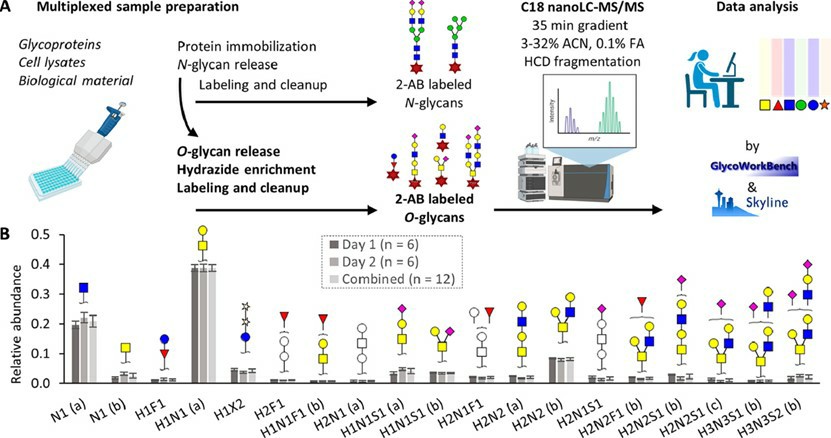Identification and Characterization of Protein Glycosylation
Glycoprotein detection is a complex field that requires new technology and expertise to perform effectively. Creative Biolabs is a global professional company that provides high-quality glycoprotein analysis services to support the research of glycoprotein structure and function.
Glycosylation is an extensive and mysterious post-translational modification. Most proteins in organisms are glycosylated. Glycosylation has profound effects on the folding of protein, protein interaction, and signal transduction. In recent years, protein glycosylation has attracted more and more attention, because abnormal glycosylations are related to metabolism, neurodegenerative diseases and tumor diseases. Therefore, the determination and analysis of protein glycosylation are becoming more and more important.
 Fig.1 Glycosylation analysis of glycoproteins.1
Fig.1 Glycosylation analysis of glycoproteins.1
Analysis of Protein Glycosylation
There are many types of proteoglycans and different combinations of glycosylation. Even a single protein may undergo many N- and O-glycosylation. It is worth noting that the glycosylation modification is heterogeneous. Based on the above reasons, there is still a lot of work to be done in the accurate determination of glycosylation.
The most direct and quick way to determine whether a protein is glycosylated is to analyze it on SDS-PAGE and stain the gel with glycoproteins. In addition, with the development of science and technology, a variety of more specific methods based on lectins have gradually been developed for the characterization of glycoproteins.
-
Glycan structure analysis
After confirming the glycosylation of the protein, the glycan structure can be analyzed. Glycans are removed from proteins mainly through enzymatic or chemical methods. After being released from glycoproteins, the glycans must be processed to remove certain contaminants before further analysis. Chromatography and mass spectrometry (MS) are used for glycan detection. Compared with chromatography, the results measured by MS are more reliable.
In addition to structural analysis, the identification of glycosylation sites has also received extensive attention. A deep understanding of glycosylation sites can better study the function of glycans. What's more, matching a certain structure with a specific site is also helpful to clarify the glycosylation characteristics of the protein.
In recent years, much attention has been focused on glycoprotein quantification. Various efficient and complex techniques are used to determine the fine structure of glycans, such as MS, liquid chromatography or nuclear magnetic resonance (NMR). Isotopic labeling is also suitable for the quantification of glycans. In fact, only the effective combination of different separation techniques and analysis methods can provide more reliable results for glycan structure and characterization.
After years of research, we have accumulated professional technology and established an advanced platform, and become a leader in the field of glycoprotein analysis. We hope to help you accelerate the discovery and cooperate with you to explore glycoprotein. Please contact us for more details.
Reference
-
Trbojević-Akmačić, Irena, et al. "High-throughput glycomic methods." Chemical reviews 122.20 (2022): 15865-15913. Distributed under Open Access license CC BY 4.0, without modification.
For Research Use Only.
Resources

 Fig.1 Glycosylation analysis of glycoproteins.1
Fig.1 Glycosylation analysis of glycoproteins.1



